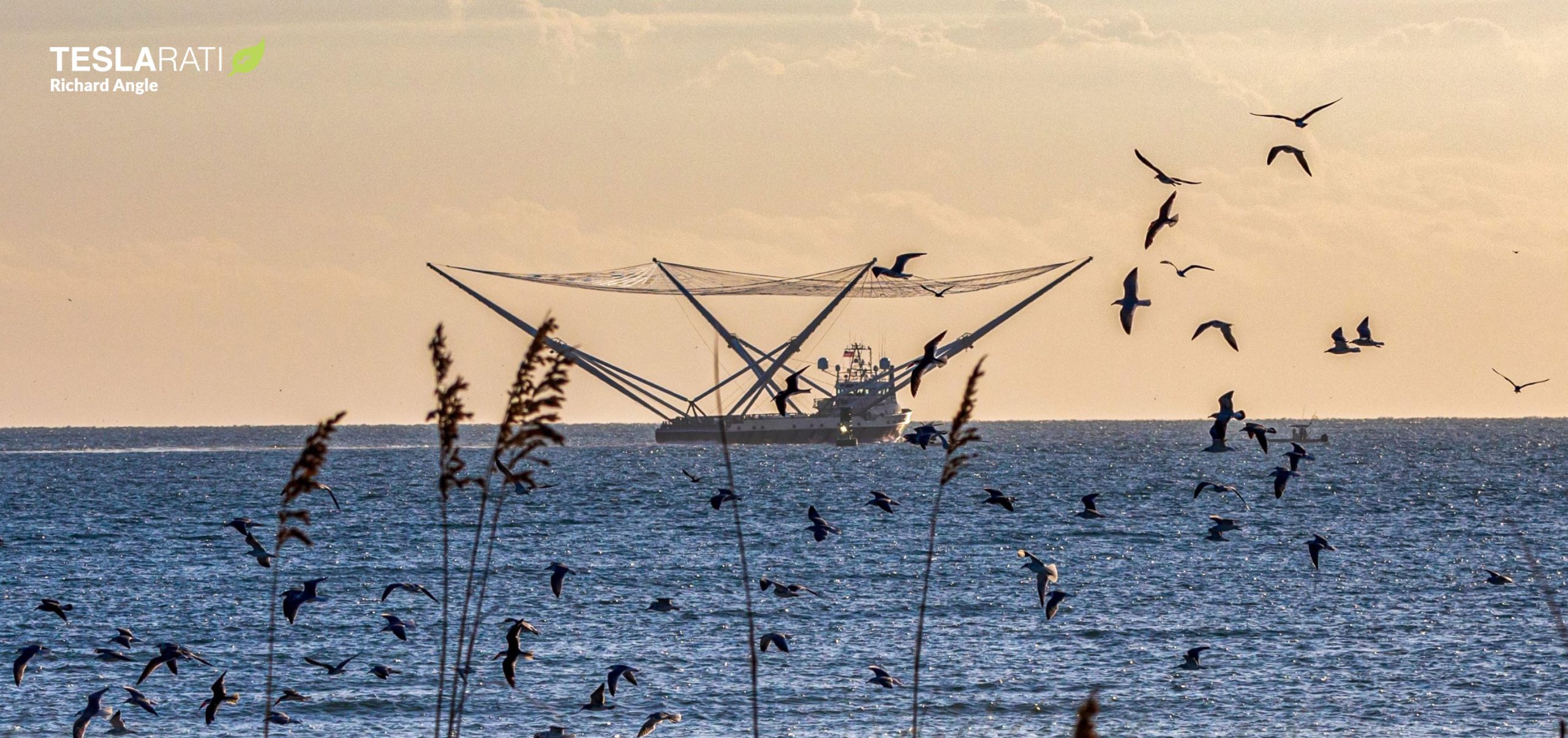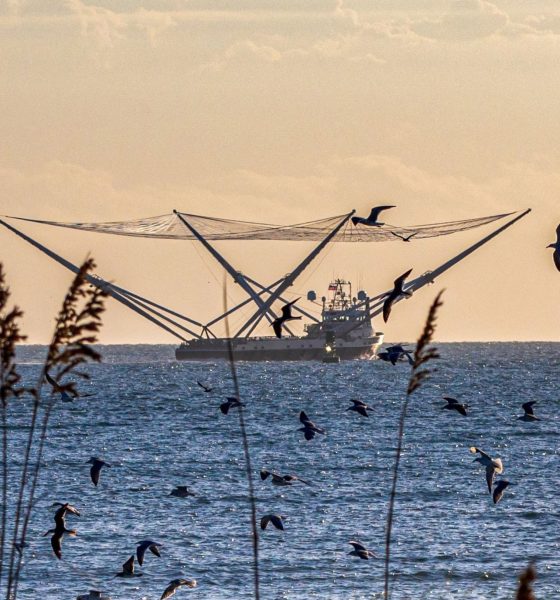

News
SpaceX’s new Falcon 9 fairing recovery ship kicks off sea trials ahead of next launch
After a brief installation period, SpaceX’s second Falcon 9 fairing-catching ship departed Port Canaveral to begin sea trials with its new net and arms, a critical step before it can be declared ready to attempt its first fairing recovery.
Known as GO Ms. Chief, the ship’s first opportunity could come as early as a few weeks from now, potentially marking a major milestone for SpaceX’s fairing recovery and reuse program.
On his first shoot for Teslarati, photographer Richard Angle (@RDAnglePhoto) managed to capture Ms. Chief while departing Port Canaveral on October 23rd, heading a few miles off the coast to kick off sea trials likely focused on proving out a wide range of new hardware installed in the last month. Those trials began less than 24 hours after technicians installed Ms. Chief’s recovery net for the first time ever, with the ship’s subsequent trip into the Atlantic Ocean essentially marking the completion of her transformation from fast supply vessel (FSV) to SpaceX fairing catcher.
SpaceX is currently in the midst of its longest lull in launch activity since September 2016, likely triggered by the unavailability of customer payloads and the company’s own internal Starlink missions. Unfortunately, although the lull was initially expected to end as early as mid-October, the internal Starlink launch (Starlink-1) expected to lead the charge slipped about a month for unknown reasons and is now expected no earlier than November – likely in the second half of the month.
As a small consolation, Starlink-1’s launch delays mean that the newly-outfitted Ms. Chief may be able to inaugurate its new net and arms by attempting to recover one of the mission’s Falcon 9 fairing halves, while the nearly identical GO Ms. Tree attempts to snag the other half. Even if more tweaking and sea trials are needed to prove her readiness, SpaceX’s next launch is still likely several weeks away, hopefully giving the company’s recovery team plenty of time to prepare Ms. Chief and practice recovery operations.
As of October 2019, SpaceX has successfully caught two Falcon fairing halves during the company’s last two back-to-back recovery attempts, beginning with a Falcon Heavy fairing half caught on June 25th and ending with a Falcon 9 fairing half caught on August 7th. Beyond Ms. Tree’s two catches, SpaceX has successfully recovered a number of additional fairing halves after they performed soft landings in the Atlantic Ocean, including both halves launched in May 2019 for the company’s first dedicated Starlink mission.
Given that SpaceX has technically caught two halves of a payload fairing, it’s possible that one is female and the other male, potentially meaning that one of SpaceX’s upcoming Starlink launches could feature the first fully-reused Falcon 9 fairing. Regardless, assuming one or both were recovered in good condition, it’s even more likely that at least one half (with the other half new) will be reused on one (or both) of those upcoming flights.
Said by CEO Elon Musk to make up approximately 10% of the cost of a new Falcon 9 (~$6M), routine fairing recovery and reuse would close the last remaining loop for Falcon 9 reusability, with boosters and fairings accounting for roughly 75-80% of the total cost of the rocket. SpaceX has no plans to attempt to recover or reuse Falcon 9’s second stage, choosing instead to prioritize development of the fully-reusable Starship launch vehicle.
Preparing the oven-cured carbon composite shells that make up the bulk of SpaceX’s Falcon fairings takes a disproportionate amount of time and factory floor space. Even if Falcon fairings can only be reused once or twice, it would effectively double or triple the effectiveness of the current manufacturing apparatus, cutting the relative cost of production by 50% or more for the price of operating Ms. Tree and Ms. Chief.
Fairing reuse will be a critical part of ensuring that the first phase of SpaceX’s Starlink constellation can be launched as affordably as possible on Falcon 9. With at least 24 launches needed to cover most populated areas, cutting even a few million dollars per launch could produce savings on the order of $100M, equivalent to the production cost of 100-200 Starlink satellites.
Check out Teslarati’s Marketplace! We offer Tesla accessories, including for the Tesla Cybertruck and Tesla Model 3.

News
Tesla gets a win in Sweden as union withdraws potentially “illegal” blockade
As per recent reports, the Vision union’s planned anti-Tesla action might have been illegal.

Swedish union Vision has withdrawn its sympathy blockade against Tesla’s planned service center and showroom in Kalmar. As per recent reports, the Vision union’s planned anti-Tesla action might have been illegal.
Vision’s decision to pull the blockade
Vision announced the blockade in early December, stating that it was targeting the administrative handling of Tesla’s facility permits in Kalmar municipality. The sympathy measure was expected to start Monday, but was formally withdrawn via documents sent to the Mediation Institute and Kalmar Municipality last week.
As noted in a Daggers Arbete report, plans for the strike were ultimately pulled after employer group SKR highlighted potential illegality under the Public Employment Act. Vision stressed its continued backing for the Swedish labor model, though Deputy negotiation manager Oskar Pettersson explained that the Vision union and IF Metall made the decision to cancel the planned strike together.
“We will not continue to challenge the regulations,” Petterson said. “The objection was of a technical nature. We made the assessment together with IF Metall that we were not in a position to challenge the legal assessment of whether we could take this particular action against Tesla. Therefore, we chose to revoke the notice itself.”
The SKR’s warning
Petterson also stated that SKR’s technical objection to the Vision union’s planned anti-Tesla strike framed the protest as an unauthorized act. “It was a legal assessment of the situation. Both for us and for IF Metall, it is important to be clear that we stand for the Swedish model. But we should not continue to challenge the regulations and risk getting judgments that lead nowhere in the application of the regulations,” he said.
Vision ultimately canceled its planned blockade against Tesla on December 9. With Vision’s withdrawal, few obstacles remain for Tesla’s long-planned Kalmar site. A foreign electrical firm completed work this fall, and Tesla’s Careers page currently lists a full-time service manager position based there, signaling an imminent opening.
News
Tesla Semi program Director teases major improvements

Tesla Semi Program Director Dan Priestly teased the major improvements to the all-electric Class 8 truck on Thursday night, following the company’s decision to overhaul the design earlier this year.
Priestley said he drove the Semi on Thursday, and the improvements appear to be welcomed by one of the minds behind the project. “Our customers are going to love it,” he concluded.
Just drove the redesigned Semi. Our customers are going to love it. https://t.co/KZ88sf1CDL
— Dan Priestley (@danWpriestley) December 19, 2025
The small detail does not seem like much, but it is coming from someone who has been involved in the development of the truck from A to Z. Priestley has been involved in the Semi program since November 2015 and has slowly worked his way through the ranks, and currently stands as the Director of the program.
Tesla Semi undergoes major redesign as dedicated factory preps for deliveries
Tesla made some major changes to the Semi design as it announced at the 2025 Annual Shareholder Meeting that it changed the look and design to welcome improvements in efficiency.
Initially, Tesla adopted the blade-like light bar for the Semi, similar to the one that is present on the Model Y Premium and the Cybertruck.
Additionally, there are some slight aesthetic changes to help with efficiency, including a redesigned bumper with improved aero channels, a smaller wraparound windshield, and a smoother roofline for better aero performance.
All of these changes came as the company’s Semi Factory, which is located on Gigafactory Nevada’s property, was finishing up construction in preparation for initial production phases, as Tesla is planning to ramp up manufacturing next year. CEO Elon Musk has said the Semi has attracted “ridiculous demand.”
The Semi has already gathered many large companies that have signed up to buy units, including Frito-Lay and PepsiCo., which have been helping Tesla test the vehicle in a pilot program to test range, efficiency, and other important metrics that will be a major selling point.
Tesla will be the Semi’s first user, though, and the truck will help solve some of the company’s logistics needs in the coming years.
News
Tesla dominates in the UK with Model Y and Model 3 leading the way

Tesla is dominating in the United Kingdom so far through 2025, and with about two weeks left in the year, the Model Y and Model 3 are leading the way.
The Model Y and Model 3 are the two best-selling electric vehicles in the United Kingdom, which is comprised of England, Scotland, Wales, and Northern Ireland, and it’s not particularly close.
According to data gathered by EU-EVs, the Model Y is sitting at 18,890 units for the year, while the Model 3 is slightly behind with 16,361 sales for the year so far.
The next best-selling EV is the Audi Q4 e-tron at 10,287 units, lagging significantly behind but ahead of other models like the BMW i4 and the Audi Q6 e-tron.
GOOD NEWS 🇬🇧 Tesla is absolutely crushing the UK electric vehicle market in 2025 💥
The numbers are in, and the dominance is clear. With an impressive amount of 42,270 vehicles delivered year-to-date, the brand now commands a solid 9.6% market share of the total auto market 🆒… pic.twitter.com/dkiGX9kzd0
— Ming (@tslaming) December 18, 2025
The Model Y has tasted significant success in the global market, but it has dominated in large markets like Europe and the United States.
For years, it’s been a car that has fit the bill of exactly what consumers need: a perfect combination of luxury, space, and sustainability.
Both vehicles are going to see decreases in sales compared to 2024; the Model Y was the best-selling car last year, but it sold 32,610 units in the UK. Meanwhile, the Model 3 had reached 17,272 units, which will keep it right on par with last year.
Tesla sold 50,090 units in the market last year, and it’s about 8,000 units shy of last year’s pace. It also had a stronger market share last year with 13.2 percent of the sales in the market. With two weeks left in 2025, Tesla has a 9.6 percent market share, leading Volkswagen with 8 percent.
The company likely felt some impact from CEO Elon Musk’s involvement with the Trump administration and, more specifically, his role with DOGE. However, it is worth mentioning that some months saw stronger consumer demand than others. For example, sales were up over 20 percent in February. A 14 percent increase followed this in June.








